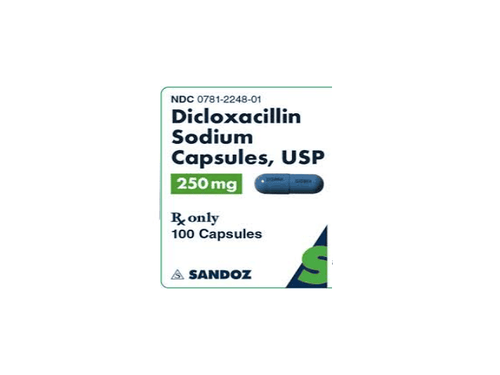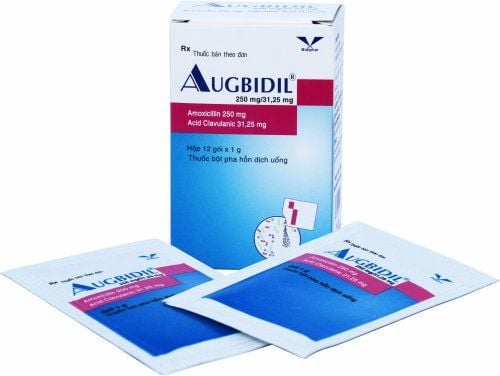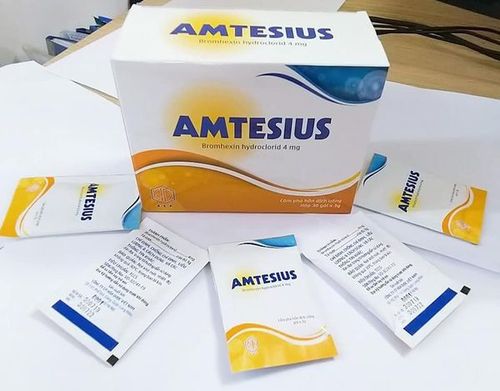This is an automatically translated article.
Padiozin belongs to the group of drugs to treat parasites, anti-infectives, antivirals, and antifungals. The drug is prepared in the form of a powder for injection, box size 1 vial + 1 ampoule of sterile water for injection 5ml. Refer to some information about Padiozin in the article below to help you know how to use the drug appropriately.
1. Ingredients in the drug Padiozin
The main ingredient in Padiozin is Ceftazidime, a 3rd generation Cephalosporin antibiotic, which has bactericidal effect by inhibiting bacterial cell wall synthesis enzymes. Ceftazidime is stable to most bacterial beta-lactamases, except Bacteroides enzymes. Ceftazidime is susceptible to many Gram-negative bacteria that are already resistant to Aminoglycoside antibiotics and other Gram-positive bacteria resistant to Ampicillin and Cephalosporins.
Ceftazidime works well against aerobic gram-negative bacteria, including Pseudomonas, Shigella, Salmonella, E.coli, Proteus, Klebsiella, Haemophylus influenza... Some strains of Moraxella catarrhalis, Pneumococcus, beta-hemolytic Streptococcus and Streptococcus viridans . Many anaerobic gram-positive strains are also susceptible to ceftazidime but moderately sensitive to staphylococcus aureus.
2. What are the effects of Padiozin?
Padiozin is a prescription drug, effective in the treatment of the following medical conditions:
Blood poisoning, bacteremia; Meningitis ; Pneumonia, lung abscess; Bronchiectasis ; Bronchiolitis; Cystic fibrosis of the pancreas; otitis media; Mastoiditis ; Nasal sinusitis; Infections in other serious medical conditions; pyelonephritis; Prostatitis; Cystitis; Inflammation of the urinary tract; erysipelas, abscess, cellulitis; Secondary infection in burns or skin wounds; Mastitis; Skin ulcers; Cholangitis ; Purulent cholecystitis; Peritoneal abscess; Peritonitis; Diverticulitis; Enteritis - colon; Pelvic and hip infections; Inflammation of the bone; Myelitis; Infectious arthritis; Infectious bursitis. Treatment of severe infections in patients with impaired immune function due to blood.
3. How to use Padiozin
Padiozin is administered by injection or by intravenous infusion or deep intramuscular injection. The dose of Padiozin depends on the severity of the disease, susceptibility, route of administration and on the age, weight or renal function of the patient.
Padiozin is less stable in sodium bicarbonate solution than in other injection solutions. Therefore, the use of sodium bicarbonate solution as a solution for solution for injection of Padiozin is not recommended.
Use of Padiozin in adults:
The usual dose of Padiozin is 0.5g-2g x 2 or 3 times a day, intravenously or intramuscularly. In the treatment of urinary tract infections and non-serious infections: The usual dose of Padiozin is 500 mg or 1 g every 12 hours as the case may be, intravenously or intramuscularly. In most infections: Padiozin 1g every 8 hours or 2g every 12 hours, intravenously or intramuscularly. In serious infections, especially in immunocompromised patients: Padiozin 2g every 8 or 12 hours or 3g every 12 hours, intravenously or intramuscularly. In the treatment of pancreatic cystic fibrosis: The dose of Padiozin in patients with pancreatic cystic fibrosis with normal renal function with Pseudomonas pulmonary infection should be used in high doses from 100 to 150mg/kg/day, divided into 3 times/day, intravenously or intramuscularly. There have been cases of using Padiozin at a dose of 9g/day in people with normal renal function. Use in children:
The usual dose of Padiozin in children over 2 months of age is 30-100mg/kg/day, divided into 2 or 3 times. For children with immunodeficiency disease, infected pancreatic cystic fibrosis, or meningitis, the dose of Padiozin can be up to 150mg/kg/day. The dose of Padiozin in infants and children under 2 months of age is 25-60mg/kg/day in 2 divided doses. Use of Padiozin in the elderly:
Normally, the daily dose of Padiozin should not exceed 3g, especially in people over 80 years old. Use of Padiozin in people with impaired renal function:
In patients with impaired renal function, Padiozin is excreted more slowly than normal, so it is necessary to reduce the dose accordingly, except mild renal failure. In patients with suspected impaired renal function, an initial dose of Padiozin of 1g may be used. Thereafter, an assessment of the glomerular clearance should be performed to determine the appropriate maintenance dose of Padiozin. Note: The above dose of Padiozin is for reference only. The specific dose of Padiozin depends on the condition and the progression of the disease. To get the right dose of Padiozin, you need to consult with your doctor or healthcare professional.
4. Be careful when using Padiozin
Do not use Padiozin in people with a history of hypersensitivity to drugs or antibiotics of the Cephalosporin group. If it is necessary to use it, it should be used with caution. Before starting treatment with Ceftazidime, it is necessary to ask carefully whether the patient has a history of hypersensitivity to penicillins or beta-lactam antibiotics. Use caution when using the drug in patients whose relatives are sensitive to the causative agent of allergic symptoms such as bronchial asthma, rash, urticaria... Patients with severe renal dysfunction. Patients who cannot receive oral nutrition or are receiving parenteral nutrition, may have poor health status, and are elderly. Before using Padiozin, it is recommended to test for drug sensitivity to prevent drug-resistant bacteria. Examine the patient's physical and clinical condition before taking Padiozin to predict possible reactions such as shock. If an allergic reaction occurs, ceftazidime should be discontinued. In the event of a severe hypersensitivity reaction, Glucocorticoids, Epinephrine and antihistamines or other emergency measures should be used. Long-term use of Padiozin may lead to overgrowth of non-susceptible strains of bacteria, such as Candida, Enterococci. At usual therapeutic doses, Padiozin did not have an adverse effect on renal function. However, because Padiozin is eliminated by the kidneys, it is necessary to reduce the dose according to the degree of renal impairment to avoid clinical consequences. The safety of Padiozin in pregnancy has not been established. Therefore, Padiozin should only be used in this population when the potential benefits outweigh the possible risks. A small amount of Padiozin is excreted in human milk, therefore caution should be exercised when administering the drug to a nursing mother. For clinical tests, a false-positive reaction for urine glucose can occur if tested with Benedict and Fehling's solution, Clinitest tablets; The Coomb test can give false-positive results, so caution should be taken. Intravenous administration of large amounts of Padiozin may cause vasculitis or thrombophlebitis. Need to carefully prepare injection solution, injection site and method of injection, should be injected at a slow rate. The solution for injection should be used immediately after reconstitution. If reconstituted but cannot be injected immediately, it can be stored for 6 hours at room temperature or 72 hours in the refrigerator. Co-administration of Vancomycin with Ceftazidime may cause precipitation. Therefore, it is necessary to clean the instrument and the IV line between administrations of these two drugs. Sodium bicarbonate should not be used as a solution for injection because it makes Ceftazidime less stable than other solutions for injection.
5. Contraindications to using Padiozin
Padiozin should not be used in the following cases:
People with a history of shock when using Padiozin. Hypersensitivity to cephalosporin antibiotics. Contraindications are absolute. This means that for any reason, Padiozin can be used in cases of contraindications. Any decision about the dose and how to use Padiozin should be made according to the doctor's prescription.
6. Interaction of Padiozin with other drugs
Simultaneous use of Padiozin with the following drugs may occur:
Aminoglycoside antibiotics; High potency diuretics, eg furosemide. The antagonism of Padiozin should be considered when used in combination with chloramphenicol. In order to avoid unwanted interactions when using Padiozin, patients should inform their doctor/pharmacist of all medicines, dietary supplements, vitamins and herbs... that are being prescribed. Fit.
7. Side effects of the drug Padiozin
Possible side effects of Padiozin include:
Anaphylaxis; Skin rash, hives; Angioedema; Lyell's syndrome; Stevens-Johnson syndrome ; Headaches; Dizzy; Paresthesia and decreased taste; There have been some cases of neurological sequelae, including myoclonic tremor, convulsions in patients with renal impairment who received ceftazidime but did not reduce the dose appropriately. Decreased pancytopenia, white blood cells, granulocytes, neutrophils and platelets; Agranulocytosis; Hemolytic anemia; Increased lymphocytes, platelets, eosinophils; Transient increases in blood urea, blood nitrogen, and serum creatinine. Rarely jaundice, elevated liver enzymes/bilirubin; Colitis, pseudomembranous colitis; nausea, vomiting, diarrhea, loss of appetite, increased thirst, rash. Interstitial pneumonia, cough, difficulty breathing; Inflammation of the oral mucosa; Candida infection; Lack of vitamin K, vitamins of group B; Other side effects include phlebitis/thrombophlebitis when administered intravenously, pain and inflammation in the case of intramuscular injection. When experiencing side effects of Padiozin, the patient should stop using the drug and notify the doctor or ask a relative to take him to the nearest medical facility for timely treatment.
8. Padiozin overdose and treatment
Signs of overdose:
Overdosage of Padiozin has been seen in some patients with renal failure. Reactions include seizures, encephalopathy, tremors, and neuromuscular excitability. Patients with acute overdose should be carefully monitored and given supportive treatment. Overdose can also lead to neurological sequelae, including encephalopathy, seizures, and coma. Treatment of Padiozin overdose:
Ceftazidime serum concentrations can be reduced by dialysis. The article has provided information on what Padiozin has, dosage and notes when using. Because Padiozin is a prescription drug, patients should not use it on their own, but need to contact a doctor or a qualified person directly to have a suitable prescription to ensure safety for health.
Please dial HOTLINE for more information or register for an appointment HERE. Download MyVinmec app to make appointments faster and to manage your bookings easily.













